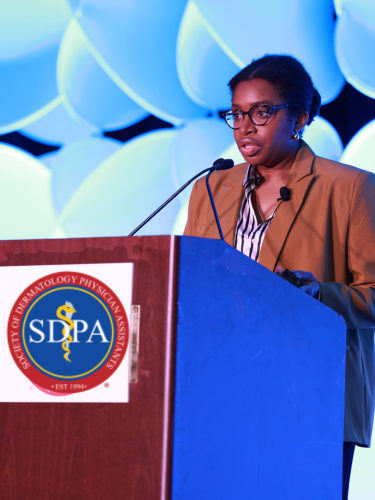Sotonye E. Imadojemu, MD, MBE, FAAD, began her lecture on pregnancy dermatoses by focusing on benign conditions of pregnancy such as linea nigra, melasma, striae gravidarum and palmar erythema. Dr. Imadojemu, a dermatologist at Brigham and Women’s Hospital in Boston, said there tends to be confusion regarding nevi in pregnancy and reports there is insufficient evidence that moles do darken in pregnancy. She said any changing nevus that would raise concern for malignancy in the nonpregnant patient should be obtained promptly in pregnant patients as biopsies and excisions can be performed safely during pregnancy.
Coverage: SDPA Annual Summer Dermatology Conference, June 22-25, 2023 – BOSTON
Next, therapeutics in pregnancy was reviewed. Topical steroids do not increase the risk of malformations or preterm delivery; however, fetal growth restriction has been reported with extensive use of potent topical steroids. Topical steroids can also add to the risk of striae development. Prednisolone is the systemic corticosteroid of choice because it is largely inactivated in the placenta. Prednisolone can be given both PO and IV and has a 1:1 conversion to prednisone.
There is debate about prednisone usage in 8-11 weeks gestation for doses >10 mg for >10 days because of research showing a slight increased risk of the fetus developing cleft palate/lip. Additionally, if prednisone is used late in the gestational period for long-term use, there should be monitoring for adrenal insufficiency. Lastly, narrowband, broadband UVB and excimer laser are all safe in pregnancy.
Dr. Imadojemu further highlighted common and rare eruptions in pregnancy. A rare presentation which can lead to significant morbidity and mortality is impetigo herpetiformis (IH). IH typically presents in the third trimester. This condition may first present in intertriginous areas and expand to the trunk and extremities. Patients with IH may present with systemic symptoms and oral and esophageal mucosal lesions. Unfortunately, this condition commonly recurs in subsequent pregnancies. A more common presentation is polymorphic eruption of pregnancy (PUP). This presents more frequently in primiparous patients and in pregnancies with multiple gestations. Fortunately, PUP carries no risk to mother or baby and doesn’t typically recur with subsequent pregnancies. Additional conditions Dr. Imadojemu discussed included atopic eruption of pregnancy and gestational pemphigoid.
Byline: Sarah B.W. Patton, PA-C
Pictured: Sotonye E. Imadojemu, MD, MBE, FAAD

